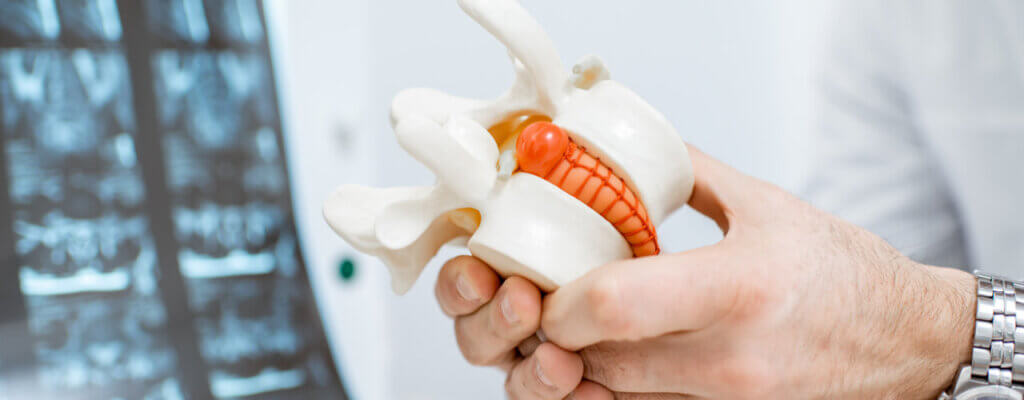Are You Living with Persistent Back Pain?
A herniated disc is a condition that occurs along the spine. Most often, it is found in the lower back. The spine is comprised of 24 bones, and five of them are found in the lower back. There are also nerves and intervertebral discs in the spine.
Strange neck pains, back pains, or extremity symptoms can indicate a variety of potential problems – including one or more herniated discs.
With a herniated disc, the jelly-like nucleus begins to push against its outer ring. If the pressure continues, it may push through the outer ring and begin to bulge. Generally, low back pain is the first symptom of this condition.
Symptoms may include pain on one side of the body, pain that radiates to the arms or legs, aching, burning sensations in the affected area, and pain with certain movements.
Other symptoms may include weakness in the legs, shooting pain down the back of one leg, numbness in the legs or loss of bladder control. Back pain can range from moderate to severe.
Some of the most common treatment options recommended by our physical therapists for herniated disc pain include:
- Ultrasound therapy or electrical muscle stimulation for fast pain relief and deep penetration of the targeted area
- Alternating treatment with ice and heat to reduce inflammation and soothe sore muscles.
- Therapeutic massage to help ease sore muscles
- Aerobic exercises like walking or using a stationary bicycle
- Stretching exercises that help to keep the muscles in the back flexible
Contact Synergy Manual PT today to see how physical therapy can help you live a pain-free life.
Physical therapy and herniated disc relief
Research shows that physical therapy is effective for treating herniated discs. If your symptoms are affecting your activities of daily life or work, or if your symptoms persist for longer than two weeks, we recommend consulting with a physical therapist.
A physical therapist will begin with passive treatments for herniated discs. Passive physical treatments include deep tissue massage, cold therapy, hydrotherapy, transcutaneous electrical nerve stimulation (TENS) and traction.
Deep tissue massage utilizes pressure to relieve muscle tension and spasms. Hot therapy may be used to increase blood flow to the target area to accelerate healing. Cold therapy helps reduce inflammation. Hydrotherapy relaxes muscles and brings pain relief. The TENS machine uses an electrical current that triggers the release of endorphins, which are the body’s natural painkillers. Traction may be implemented to reduce pressure on the spine.
A physical therapist will also have you engage in active treatments for disc herniation. You’ll engage in core exercises to strengthen your back, muscle strengthening exercises, and stretching and flexibility movements to increase movement.
With physical therapy, your therapist will teach you self-care principles to maintain a healthy lifestyle. Physical therapy has been proven to be effective for disc herniation. It is a noninvasive alternative to surgery and prescription painkillers.
How can I know if I have a herniated disc?
After discussing your symptoms with a doctor, a physical exam will be performed to determine whether or not you have a herniated disc. A neurological exam may also be done. During this exam, muscle strength and sensation will be assessed.
A magnetic resonance imaging (MRI) scan may be done to confirm the diagnosis. This scan is able to show a herniated disc in the lower back region. If the disc is putting pressure on the spine, it can be detected. Likely, your doctor will recommend physical therapy for pain relief.
What are the risks of leaving a herniated disc untreated?
A herniated disc is typically the result of the wearing down of the spine due to age. It’s known as disc degeneration. When you’re young, the discs in the spine contain a high water content. With age, the water content decreases and the discs begin to shrink.
This process makes the aging process prone to disc herniation. Risk factors for back pain and a herniated disc include being a male between the ages of 20 and 50, being overweight, engaging in improper lifting and repetitive activities, driving frequently, and having a sedentary lifestyle.
Lifting heavy objects improperly can cause a herniated disc. Other risk factors include weight and genetics. Excess body weight causes more stress on the discs. And genetics can predispose one to developing a herniated disc.
When doing something that is physically demanding, it is important to use safe movement techniques to prevent an injury such as a herniated disc.
Find relief for your back pain today
Are you suffering from back pain? If so, give us a call. Our experienced and certified physical therapists can assist you with back pain or a herniated disc.
An individualized treatment plan will be created to target the affected area. Why suffer from pain when physical therapy can help get you on the road to recovery and good health? Contact Synergy Manual PT today to schedule an appointment.
Tags: Therapeutic massage, physical activity, fitness, Synergy Manual Physical Therapy, wellness, chronic back pain, back pain, herniated disc, physical therapy, back pain relief, health, ultrasound therapy, physical fitness, electrical muscle stimulation, physical therapist

